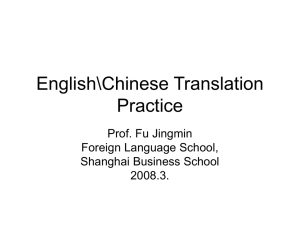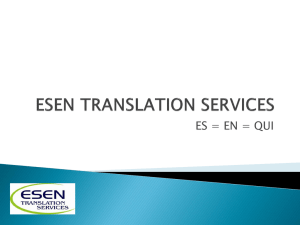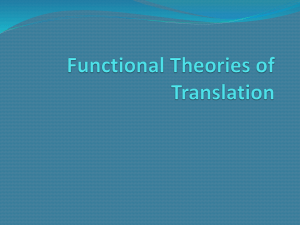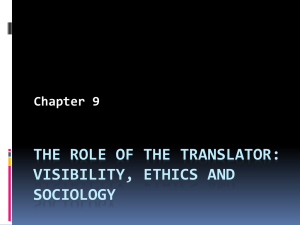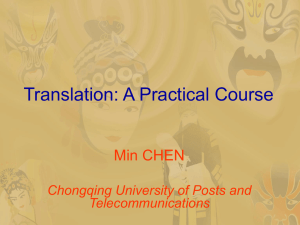Translating culture
advertisement
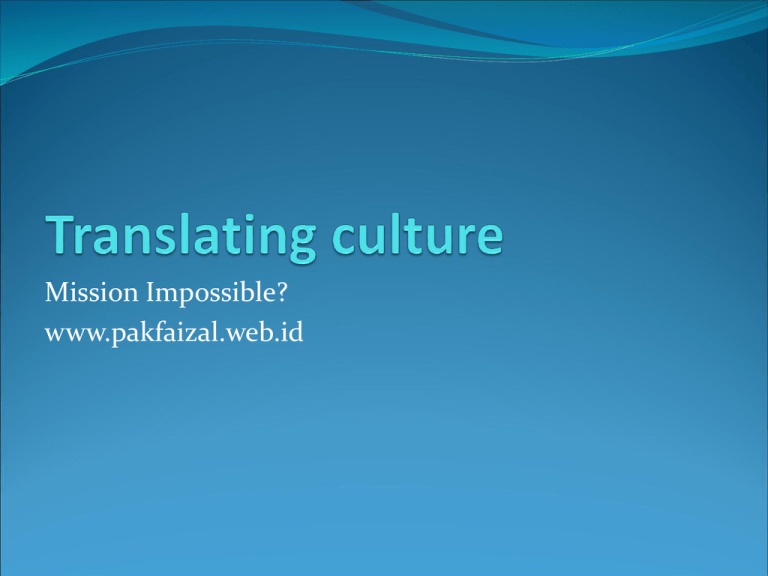
Mission Impossible? www.pakfaizal.web.id Language is an expression of culture and individuality of its speakers. It influences the way the speakers see or perceive the world. This principle has a far-reaching implication for the latest research on translation theories. It has been long taken for granted that translation deals only with language. Cultural perspective, however, has never been brought into discussion. This can be seen in most of the following definitions. The first definition is presented by Catford (1965: 20). He states that “Translation is the replacement of textual material in one language by equivalent textual material in another language”. In this definition, the most important thing is equivalent textual material. Yet, it is still unclear in terms of the type of equivalence. Culture is not taken into account. Next, Nida and Taber (1969) explain the process of translating as follows. Translating consists of reproducing in the receptor language the closest natural equivalent of the source language message, first in terms of meaning and secondly in terms of style. Nida and Taber themselves do not mention the aspect of culture in translation process. Following their explanation on "closest natural equivalent", however, we can infer that cultural consideration is considered. They maintain that the equivalent sought after in every effort of translating is the one that is so close that the meaning/message can be transferred well. The concept of closest natural equivalent is rooted in Nida's concept of dynamic equivalent. His celebrated example is taken from the Bible, that is the translation of "Lamb of God (anak domba Allah)" into the Eskimo language. Here "lamb" symbolizes innocence, especially in the context of sacrifice. As a matter of fact, Eskimo culture does not know "lamb". Thus, the word does not symbolize anything. Instead of "Lamb of God", he prefers "Seal (anjing laut) of God" to transfer the message. Here he considers cultural aspects. Instances of cultural translation (1) SL: Dalam masyarakat Jawa bila seseorang wanita atau istri sedang hamil, menurut tradisi perlu diadakan bermacam-macam selamatan dan upacara-upacara lainnya. Hal ini perlu dilaksanakan dengan maksud agar bayi yang dikandung akan lahir dengan mudah dan selamat sehingga si anak akan mendapat kebahagiaan hidup dikemudian hari. (Bratawidjaja, 1996: 11). TL: In a Javanese community, based on traditions, a pregnant woman or wife should be celebrated with various kinds of selamatan (traditional fiest?) and rituals. These should be done so that she can give a birth to a child easily and safely and the newly-born will get happy life later. (2) SL: Upacara siraman dilakukan pada pagi hari sekitar pukul 09.00. Upacara siraman dilakukan oleh ibu dari anak yang diruwat dengan air kembang setaman. Setelah dibersihkan anak itu mengenakan busana adat Jawa yang secara khusus dibuat. Anak yang diruwat diajak oleh Ki Dalang serta didampingi oleh para pisisepuh (neneknya, budenya, dan lain sebagainya) untuk bersujud di hadapan ayah dan ibunya (Bratawidjaja, 1996: 49) TL: Siraman (showering?) ceremony is held in the morning around 09:00 o’clock. This ritual is led by the mother of the child being "ruwat"(cleansed?) by showering him with "kembang setaman" (flower??)water. After being cleansed, the child is dresed in Javanese traditional clothes specially designed for him. The ("ruwat") child is then guided by Ki Dalang (the puppeteer??) and accompnied by the elders (the grandmother, aunts, etc.) to pay a homage to by bowing down to earth in front of the father and mother. Translation Procedures to Translate Culturally-bound Words or Expressions It is widely known that perfect translation of culturally-bound text is impossible. The translation focusing on the purpose of the SL text writing is, however, always possible. This can be proven with the translation of so many literary works into other languages. One of them is the translation of Mangunwijaya's Burung-burung Manyar into English by Thomas M. Hunter. Hariyanto (1997) surveys both groups of SL and TL readers and comes up with the result saying that the readers get the same impressions in terms of the meaning, message and style. Based on the result, Hariyanto (1999) studied further the appropriate procedures used to translate culturally-bound sentences, words, and expressions which are embedded in Javanese culture into English using the same novel translation as a case. The result shows that to translate culturally-bound words or expressions, the translator used addition, cultural equivalent, descriptive equivalent, literal translation, modulation, reduction, deletion, and combination. Recognized translation is best used to translate institutional terms whose translation are already recognized, such as TNI, kabupaten, kecamatan, and Kowilhan. The use of new translation with whatever procedure will make the readers may misinterpret, especially if they already have some degree of knowledge of the source language. The establishment of this recognized translation by the Indonesian Language Center or the people themselves has, of course, undergone a certain process of creation and acceptance. When something about language has been accepted, it means it is a convention: that is the heart of language or vocabulary. Professions are appropriately translated with cultural equivalents as they exist in both Javanese and English cultures. There are some differences between the two, but they are so minute. The examples can be seen in the following quotations. The SL is Indonesian and the TL is English. SL: Dan nah, tentu saja tak mau ketinggalan si gelatik cantik tetapi pencuri-pencuri padi yang nakal itu, dengan pipinya putih dan picinya biru hitam. (p. 17) TL: And not to be left out were the Java finches. With their white cheeks and their velvet-like caps of deep blue, they were lovely to look at, but as rice thieves they were a troublesome bunch. Descriptive equivalents are appropriate to translate culturally- bound words or expressions that are not found in the English culture but considered important enough in the text. When they are not, synonyms will do. See this example.SL: Langsung ia berbahasa ngoko kepadanya, seperti kepada jongos (Mangunwijaya, 1989: 106-107) TL: He rudely ordered Karjo about, using language that one might use with a servant. (Mangunwijaya, 1993: 136)The example of this case is berbahasa ngoko which is translated intowith language that one might use with a servant. If this expression was not considered very important, the synonym with hostile language could be used. Literal translation can be used to translate a Javanese word that refers to a general meaning such as sinyo Londo, which is translated into a Dutch boy. This procedure, however, should not be used to translate proper name. Expansion is found not very significant. It means that without it, the translation was still acceptable. See the following quotation .SL: Mana Si Karjo. Dikunjungi malah lari. Mandi barangkali. Atau menggodog teh barangkali (p. 156) TL: Where was Karjo? A person comes to visit and he disappears. May be he was taking a bath, or boiling water for tea? In the above example, instead of translating menggodog teh into boiling water for tea, the translator actually could translates it into preparing for tea, which is more idiomatic. Next, modulation can be used best to handle a word that has no exact equivalent in the TL and the context demands the translator to emphasize the economy and smoothness of the sentence flow. This situation usually happens in a direct quotation where cultural notes are impossible. In addition, with this procedure the translator can still recreate the smooth flow and beauty of the text. The example is the translation of mbak ayu into you and kakangmu into SL: Mbakayu itu macam-macam saja usulnya. TL: You do come up with some strange suggestions sometimes," Mbok Ranu commented. SL: Maka Kakangmu pikir: ah, tidak baik membebani orang dengan perkara-perkara yang lebih memberatkan TL: So I thought to myself that it wouldn't be right to do something that might make even more trouble. Bahasa Indonesia: A: Eh, tumben kamu di sini.. Janjian ketemu sama orang? B: Ngga, iseng aja. Udah lama ngga ke sini. English: A: Hi! I didn't expect to see you here. Meeting someone? B: Nope. Just thought I'd come here. Been a long time. Now, how would you translate the indonesian word "tumben"? what about "iseng"? you don't. you just look at the whole exchange and find expressions that best convey We should consider these items: 1) the meaning; 2) the level of formality/the context; and 3) the natural way of expressing points 1) and 2) above in both languages. The conversation is not complicated enough, if, say, we know from the context in the original text that A and B are ex-lovers, the setting is in a place where they used to spend hours just being with each other, and therefore the meeting above is a weirdo or an awkward one, then the lines that follow the openers above should reflect that awkwardness, NATURALLY, in the target language. as translators, the last thing we want is for the message to be "lost in translation", right? conclusion Finally, it can be concluded that theoretically a text which is embedded in its culture is both possible and impossible to translate into other languages. If practicality is considered first, however, every translation is possible. The degree of its closeness to its source culture and the extent to which the meaning of its source text to be retained is very much determined by the purpose of the translation. To close, it is suggested that in the translator considered the procedures explained above to translate culturallybound words or expressions.
